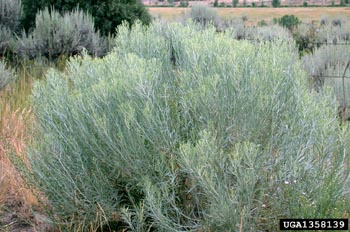Sand Sagebrush

Common Name(s):
Sand Sagebrush
Sand Sage
Threadleaf Sagebrush
Old Man Sagebrush
Scientific Name:
Artemisia filifolia Torr.
Scientific Name Synonyms:
None known
Symbol:
ARFI2
Description:
Life Span: Perennial
Origin: Native
Season: Warm
Growth Characteristics: Sand sagebrush is a freely branching, rounded crown, and aromatic shrub growing up to 4 feet tall. It flowers August to September, and reproduces from seeds.
Flowers/Inflorescence: Flowers are numerous and small, found in terminal, leafy plume-like heads.
Fruits/Seeds: Fruit is a brown, lightly 4-5 ribbed achene.
Leaves: Alternate and found in bundles (fascicled). The upper leaves are simple lance-shaped, the lower leaves are divided into 3 lobes. The leaves have a bluish-green appearance and are hairy.
Stems: Twigs are brown to grayish-brown, erect, slender, and freely branching. They can be hairy to smooth without hair. The bark eventually exfoliates in thin shreds.
Ecological Adaptions:
Sand sagebrush is found on dunes, sand hills, and deep sands. It is generally considered an indicator of sandy soil, and is usually abundant in those areas. It is found mostly in southern Utah at elevations between 3,000 and 5,000 feet.
Soils: Dry, coarse, sandy, low fertility soils.
Associated Species: Needle-and-thread, yucca, galleta grass, broom snakeweed, Indian ricegrass, and sand dropseed.
Uses and Management:
The importance of sand sagebrush to livestock and wildlife depends on the vegetative composition of a particular site. It is rarely used in grasslands where more preferred forage species are available but may be used heavily in arid desert regions where other forage is scarce or unavailable. Sand sagebrush is heavily browsed on some low elevation cold desert ranges, and furnishes forage for pronghorn and deer. It is considered a locally good forage plant for wildlife and domestic livestock in parts of southern Utah, but is otherwise considered poor to worthless as forage for cattle, and poor to fair for horses and sheep. It may cause sage sickness in horses.
Sand sagebrush provides hiding or thermal cover for numerous smaller birds and mammals.
It is extremely effective in preventing wind erosion on light, sandy soils. A canopy of sand sagebrush can afford some protection to grasses such as needle-and-thread on heavily grazed sites.
In Mexico, a decoction of leaves was taken for intestinal worms and other stomach problems.

